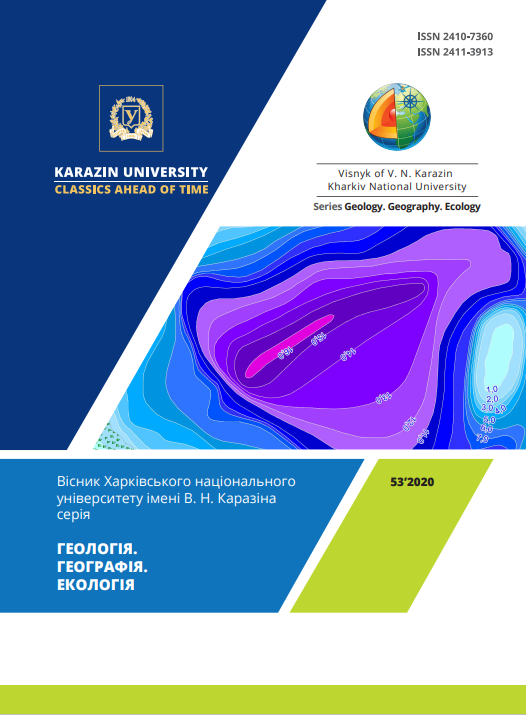Виявлення індикативних ландшафтних об’єктів в межах природоохоронних територій
Анотація
Робота присвячена ідентифікації ландшафтних об’єктів (рослинні угруповання та водні об’єкти), які змінюються впродовж часу і впливають на структуру ландшафтних комплексів. Територія дослідження знаходиться в межах природоохоронної зони, тому важливим аспектом виявлення індикаторів зміни ландшафтів рівня фацій є дистанційні методи дослідження. Створення образу ландшафтної мозаїки за допомогою космічних знімків Sentinel-2, Planet Scope, Landsat 8 дозволяє укласти карту-гіпотезу, сформувати базу даних та проаналізувати образ, який створений дистанційно. Автором було уточнено методику укладання ландшафтної карти та виявлення індикативних об’єктів і проведено експериментальні роботи щодо вибору даних космічних знімків та інструментарію обробки. Обробка даних космічних знімків дає можливість аналізувати важкодоступні території, наприклад ті, що знаходяться в зоні підвищеної охорони чи райони в містах боліт, густих лісів, гір і т. д. У процесі укладання методичних аспектів було використано і апробовано декілька методів класифікації космічних знімків: використовували автоматичну і ручну обробку. Зокрема, кращі результати отримані методом контрольованої класифікації. Вибір космічних знімків і його просторового розширення залежить від задач, поставлених перед дослідником, площі території, характеру різноманітності об’єктів та наявність можливостей покупки чи відкритого використання даних. Вибір індикаторів значно залежить від технічної обробки даних, візуального та програмного аналізу окремої території. Для природоохоронних території важливо враховувати специфіку місцевості та характер змінності образу ландшафтів під впливом природних та антропогенних факторів (так як природоохоронні території зазнають вплив від господарської діяльності людини і створенні як природні резервати екосистем та їх окремих компонентів). Виявлення індикаторів дозволяє проаналізувати, спрогнозувати ситуацію в межах природоохоронної місцевості та вжити заходів для збереження ландшафтів.
Завантаження
Посилання
Alfan H. (2017). Spatial pattern of illegal activities and the impact on wildlife populations in protected areas in the Serengeti ecosystem. York, PhD thesis, University of York. http://etheses.whiterose.ac.uk/id/eprint/20276
Bastian O., Roder M., James F. (2007). A framework for monitoring landscape functions: The Saxon Academy Landscape Monitoring Approach (SALMA), exemplified by soil investigations in the Kleine Spree floodplain (Sax-ony, Germany). Dresden, Landscape and Urban planning, 79, 2, 190-199. https://doi.org/10.1016/j.landurbplan.2006.02.005
Bodnya O. V., Ovcharenko A. Yu. (2018). Indicative landscape monitoring of national natural parks (in the appli-cation of the territory of NPP "Slobozhanskiy"). Kharkiv, V. N. Karazin Kharkiv National University, 49, 192-207. https://doi.org/10.26565/2410-7360-2018-49-15
Biatov A. P., Brusenczova N.O., Saidaxmedova N.B. et al. (2013). Appendix to the Annals of Nature of the Slo-bozhansky National Nature Park for 2012. Krasnokutsk, 136. https://zakon.rada.gov.ua/rada/show/v465_737-02/card6#Public
Bogdanov A. P., Aleshko R. A. (2016). Development of a method for monitoring the state of forests based on the use of multispectral space survey data. Arhangelsk, FBU «Severnyj nauchno-issledovatelskij institute lesnogo hozja-jstva, 98-110. https://doi.org/10.21513/0207-2564-2017-1-98-110
Cheng Y. (2019). Retrieving vegetation phenology with planetscope images for a semi-arid rangeland in Kenya. Enschede, 74. http://purl.utwente.nl/essays/83720
Goryanova V.O., Kvartenko R.O. (2012). Special features of the physical and geographical area in the national natural park "Slobozhansky". Uman, Ecology – the way of harmonizing the common nature and suspension. (11-12 october 2012.), 96-98.
Grodzynskyj M.D. (2017). Geography: the old name of the new science and the revival of the forgotten. K, Ukraini-an Geographical Journal, 2, 65-68. https://doi.org/10.15407/ugz2017.02.059
Hakan A. (2017). Analysis of landscape changes as an indicator for environmental monitoring. Environmental Monitoring & Assessment. 189, 1-10.
Hakkenberg C., Song C., Peet R. (2016). Remotely-sensed predictive models of forest composition: community-unit classification versus continuous gradient modeling. 2016AGUFM.B52A..07H
Houet T., Verburg P., Loveland T. (2010). Monitoring and modelling landscape dynamics. Landscape Ecology, 25, 163-167.
Lambin E. (2001). Remote Sensing and Geographic Information Systems Analysis. Louvain-la-Neuve, International Encyclopedia of the Social & Behavioral Sciences, 13150-13155.
Landscape monitoring using remote sensing NAU students in the Department of Geography, Planning, & Recrea-tion study the desert. https://nau.edu/gpr/landscape-monitoring-using-remote-sensing.
Ovcharenko A. Yu. (2019). Mobility of GIS-technologies in the aspect of the development of large-scale landscape mapping and practical practices of geography students. Kharkiv, «Problemy bezperervnoyi heohrafichnoyi osvity i kartohrafiyi» (na sayti Natsional'noyi biblioteky Ukrayiny imeni V. I. Vernads'koho), 30, 70-80. https://doi.org/10.26565/2075-1893-2019-30-08
Ovcharenko A. Yu. (2019). Review of the study of indicative projects of landscape monitoring using a landscape monopolist using remote sensing technologies. Kharkiv, Geographical research: the history of today, prospects: materials of the international science conference of students and the commemoration of the memory of Professor G.P. Dubinsky (11 April 2019), 12, 39-44.
Perepechena Ju. I., Glushenkov O. I., Korsikov O. I. (2017). Determination of forest cover and quantitative charac-teristics of forests using Sentinel-2 space images (on the example of na primere of the Shebekinsky municipal dis-trict of the Belgorod region). Remote methods in forest, 4, 85-93. https://cyberleninka.ru/
Somers B., Tits L, Roberts D., Werherley E. (2016). Endmember Library Approaches to Resolve Spectral Mixing Problems in Remotely Sensed Data: Potential, Challenges, and Applications. Leuven, Data Handling in Science and Technology, 30, 551-577.
Tretyakov O.S., Bodnia O.V., M.O. Balynska et al. (2015). Features of interpretation of plant association of na-tional natural park «Slobozhanskiy» using Landsat 8 satellite data. Kharkiv, Problemy bezperervnoyi geografich-noyi osvity i kartografiyi: Zbirnyk naukovyx pracz, 21, 73-79.
Villoslada M., Bunce R., Sepp K. et al (2017). A framework for habitat monitoring and climate change modelling: construction and validation of the Environmental Stratification of Estonia. Regional Environmental Change, 2, 335-349. https://doi.org/10.1007/s10113-016-1002-7
Watson D., Doeer V., Banks S. et al (2017). Monitoring ecological consequences of efforts to restore landscape-scale connectivity. Biological Conservation. 206, 201-209. https://doi.org/10.1016/j.biocon.2016.12.032





